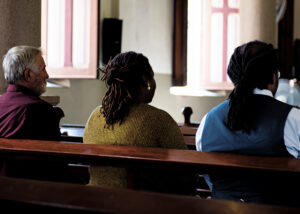So what does the Bible say about thin places?
Interestingly enough, in our Scriptures the human story begins in a thin place: the Garden of Eden. Regardless of one’s theology, and whether one believes the Garden of Eden is literal or symbolic, the narrative is clearly describing a thin place where humans experienced intimate and immediate fellowship with God, where the holy and human mingled. The story goes on to tell us that human beings were expelled from this special place after the Fall, when humanity chose to follow the way of evil, instead of God’s way.
So did the Fall mark the end of thin places on earth? According to the Bible, the answer is no.
Later on in the Book of Genesis, chapter 28, Jacob is travelling and stops at a place called Bethel. He spends the night there and has a dream of a stairway leading up to heaven, with angels ascending and descending, and the Lord, the God of Abraham, standing at the top.
In Genesis 28:16-17, we read Jacob’s reaction to this vivid dream: “When Jacob awoke from his sleep, he thought, ‘Surely the Lord is in this place, and I was not aware of it.’ He was afraid and said, ‘How awesome is this place! This is none other than the house of God; this is the gate of heaven.’ ”
It is intriguing that Jacob marvels at how awesome the place is. He immediately focusses on the physical location he is in, assuming it must possess an especially sacred quality. It wasn’t a random divine encounter in his eyes; geography had something to do with it.
In the Bible, Bethel has a prolific history as a holy place for the Israelites. It was where Abraham built one of the very first altars to God, and later on Bethel housed the Ark of the Covenant. It was also where Israelites came to offer sacrifices and receive oracles from God. For Abraham, Jacob and their descendants, Bethel was a thin place.
In Exodus 3, we read about Moses meeting God in another place with a curious reputation as a holy or thin place. Moses is tending the flock of his father-in-law, Jethro, when he comes to Horeb or Sinai; both names are traditionally understood to be referring to the same mountain. Horeb was known as the mountain of God and here Moses comes across a bush that is engulfed in flames but isn’t consumed.
As Moses approaches the strange sight, a voice speaks to him from the flames, saying, “Moses, Moses . . . . Do not come any closer. . . . Take off your sandals, for you are standing on holy ground. . . . I am the God of your father, the God of Abraham, the God of Isaac and the God of Jacob” (Genesis 3:4-6).
God tells Moses that the very ground he is standing on, the physical place he is in, is holy. One understanding is that the ground was only holy at that particular moment because God was revealing God’s presence at the time. But the fact that this mountain was already known to people in the area as the mountain of God means that Moses was undoubtedly not the first person to have had a profound God encounter there. Could it really be coincidence that Moses meets God on a mountain that people had already named the mountain of God?
Furthermore, Moses routinely ascends this particular mountain in order to communicate with God throughout the Exodus story. In fact, he ascends a total of eight, possibly nine, times to hear from the Lord. Immediately after the Hebrews escape Egypt, God leads the Hebrews south into the desert to this mountain, instead of along a direct route to the Promised Land of Canaan. When Moses and the liberated Hebrew slaves arrive in the desert of Sinai and set up camp beside this mountain, we read, “Moses went up to God, and the Lord called to him from the mountain” (Exodus 19:3).
Moses repeatedly goes to the same place, up the same mountain, to meet with God. It is there Moses receives the Ten Commandments, other laws and commands, instructions for the tabernacle and the details of the new covenant. It is there he spends 40 days with God, without food or water, and returns with a face that is glowing so bright that Aaron and the Israelites are afraid to go near him.
This mountain was clearly a very thin place.
Troy Watson is pastor of Avon Mennonite Church in Stratford, Ont.







Leave a Reply
You must be logged in to post a comment.